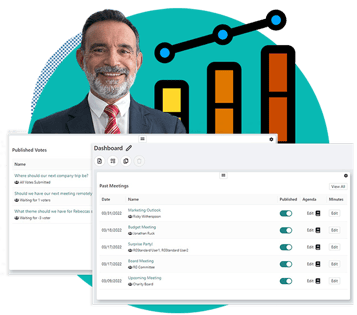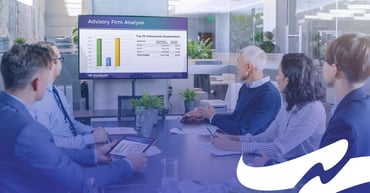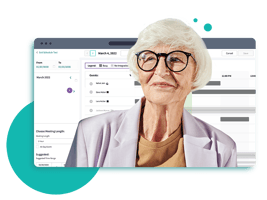 Modern boards are expected to be more engaged, efficient, and effective than ever before, and board assessments are part of improving best practices. The most valuable tool directors and executives can use to find process gaps, inventory, talent, and create strategic action plans are through the assessment process.
Modern boards are expected to be more engaged, efficient, and effective than ever before, and board assessments are part of improving best practices. The most valuable tool directors and executives can use to find process gaps, inventory, talent, and create strategic action plans are through the assessment process.
However, boards sometimes have little time to devote to conducting this process thoroughly and adequately. According to PwC’s Annual Corporate Director Survey, only 43% of directors say their self-assessment process is very effective, and 63% say they find the assessment a “check the box” exercise. So how can governance professionals make sure they get the most out of their board assessment? Board self-assessments are most effective with clear objectives, strong leadership, and commitment to reviewing results.
Driving Board Assessments with Strong, Independent Leadership
Involving strong, independent leadership is essential to driving board self-assessments. Spencer Stuart advises that independent board chairs, the chair of the governance committee, or the lead independent director are the best people to lead the process. It’s important that the leader can involve the right people, ask for all stakeholders’ time, and schedule the right amount of time to discuss the process and results.
This person will play a significant role in the assessment process because they will work with others to set clear objectives, manage the expectations, and become a valuable resource for everyone involved. They will also address concerns, interview individual directors, and deliver the information after board assessments.
Setting Clear Objectives
The adage of “fail to plan, plan to fail” holds up when addressing board assessments. The most important part of the process is setting clear objectives, goals, and outcomes. All parties involved in the assessment process need to agree with what they hope to accomplish. Setting and communicating clear goals also builds accountability and encourages board members to commit to the time and process. Oftentimes, if objectives aren’t communicated, the assessment will not elicit the desired results.
Board assessment objectives also need to be tailored to the organization’s own governance practices, industry, relevant issues, and board composition. Questions boards can ask at the onset of an assessment involve who to include, how to approach the assessment, critical areas for concern, and gaps in the current assessment process. It’s also important to determine if the assessment will evaluate board leaders individually.
Take a Closer Look at Individual Directors
Assessments are a lucrative tool to ensure that an organization’s board is being appropriately led, board members are fulfilling their responsibilities, and satisfactory oversight processes are in place. However, many boards are reluctant to take a closer look at individuals and apply this critical lens to board assessments.
A study conducted by Harvard Business Review and The Miles Group found that of the 187 boards surveyed, only 60% believe their lead director “asks the right questions,” and a shocking 26% believe they are very effective in giving direct, personal, and constructive feedback to fellow directors.
Independent leadership is also necessary to bridge this gap, but making board member expectations known from day one are critical. Assessment leaders can also incorporate directors’ self-evaluations and peer evaluations in the process. Results from this portion of the assessment should be revealed to each individual in a one-on-one interview in which the individual and assessment leader will discuss how to move forward.
Include a Different Perspective
Another avenue often overlooked in board self-assessments is individuals and departments’ opinions who regularly interact with the board and executive leadership. These opinions can give the board and individuals an outside perspective of how others perceive them and what issues or gaps should be addressed. These groups or individuals may be regular attendees at board meetings such as the general counsel, president, chief financial officer, or human resources head.
Taking a closer look at these individuals’ opinions can lead to thoughtful feedback about what the board is doing well and what they can improve upon.
Plan Ample to Time to Review Results and Create an Action Plan
It’s one thing to plan time for board self-assessments to occur, but the board must also build time into the agenda to review the results. Reviewing results is often the place where boards fall short. Allowing for ample time to review the board assessment, identify issues that were raised, and overall outcomes are critical for future planning and updating best practices.
Once boards begin the assessment process they have to also be open to discussing and dealing with the findings. Planning a retreat around the results stage of a board assessment can also be beneficial. Retreats are a great way for boards to brainstorm and collaborate on agenda items that find themselves shelved from regular board meetings.
Govenda Board Assessment Tool is a GameChanger
Board self-assessments are time-consuming. It takes time to plan, create, administer, and deliver results. But Govenda is changing the game when it comes to this process. Board assessments, a powerful part of Govenda Surveys, is a fully integrated and easy solution that simplifies the board self-assessment process and provides valuable insights on board member engagement, talent inventories, and more.
Surveys provide personalized assessments for key stakeholders to rate their experiences and provide suggestions to boost productivity and comment on their organization’s well-being. This exclusive tool is accessible on any device, which gives users the ability to navigate through an elegant platform, save answers for later, and return the assessment at a convenient time. Administrators also have an intuitive space to craft surveys with a variety of question-and-answer styles.
Board evaluations and assessments are a critical component to regular board best practices. Govenda Surveys is the answer to a once cumbersome and time-consuming process for all stakeholders involved in regular board evaluations.
Interested in learning more about Govenda’s exclusive board assessment tool?
Other posts you might be interested in
View All PostsSubscribe to email updates
Get updates delivered directly to your inbox.


